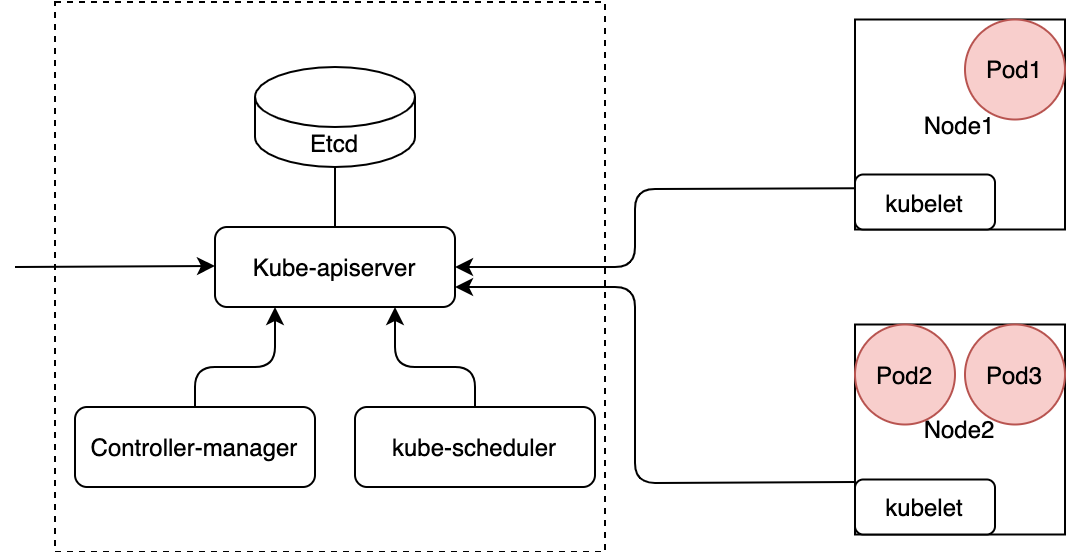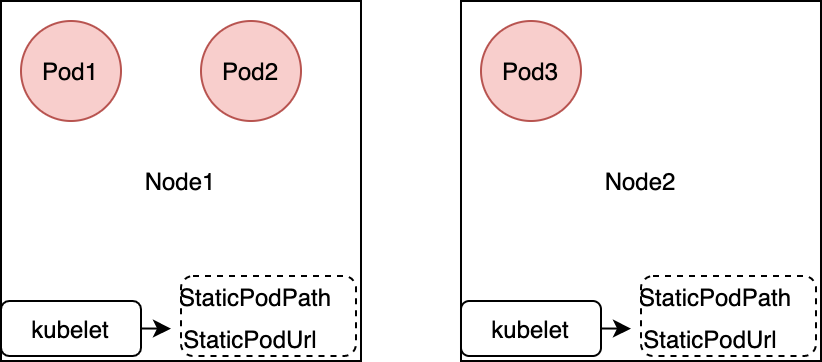Kubernetes中的Static pod实现与使用场景分析
介绍Kubernetes中的staic pod具体的实现逻辑,以及可能的使用场景。
先决知识
- Kubernetes集群的基本架构和各组件的功能
- Pod的基本概念及原理
- Kubernetes中的Deployment和Daemonset基本原理
Static pod简介
普通的Pod
Pod是kubernets中最基本的工作单元,一个Pod中可以包含一组容器。通常情况,Pod的创建流程是如下所示(以Bare Pod为例):

用户首先是请求Kube-apiserver创建Pod,当Pod被系统接受后,Pod作为一个资源对象被持久化在Etcd中,状态为Pending。控制组件Kube-scheduler通过Kube-apiserver监听到这个未被指定调度节点的Pod后,将会根据一定策略,修改Pod的status字段,标记为这个Pod理应分配到某个节点。而所有节点上的Kubelet也会通过监听Kube-apiserver来发先被调度到本节点Pod,此时Kubelet才真正意义上地根据Pod定义的信息,来在自身节点上启动Pod。
Static pod
跟Kubernetes中其他普通的Pod不一样,Static pod是直接由节点上的Kubelet管理的。只要把Pod的定义声明文件放在Kubelet所在节点的指定路径下,或者某个指定的URL地址,Kubelet就会读取Pod的定义文件,并且启动这个Pod,也会按照定义的配置管理Static pod的生命周期。Static pod的启动可以不需要集群,只节点上有Kubelet和相应容器运行时即可。

快速使用Static pod示例
Static pod的使用很简单,我们来快速试用一下吧。
Step 1:准备一台服务器作为节点;
Step 2:在节点上安装容器运行时:点我参考;
Step 3:在节点上安装Kubelet:点我参考;
Step 4:手动指定Kubelet启动参数:
kubelet –cgroup-driver=systemd –pod-manifest-path=/etc/kubernetes/manifests/ –fail-swap-on=false –pod-infra-container-image=kubernetes/pause > /tmp/kubelet.log 2>&1Step 5:观察Pod定义的容器组已被Kubelet正确启动,纳入管理:
1
2
3
4
5
6
7
8
9
10
11
12
13
14
15
16
17
18
19
20cat > /etc/kubernetes/manifests/pod.yaml <<EOF
{
"kind":"Pod",
"apiVersion":"v1",
"metadata":{
"name":"static-pod-demo",
"namespace":"default",
"uid":"114b565b-fbe0-4301-a7bd-89598ce86a7a"
},
"spec":{
"containers":[
{
"name":"nginx-container",
"image":"nginx:latest"
}
],
"restartPolicy":"Always"
}
}
EOF
Step 6:停止Static pod,只需要把Pod.yaml文件移出/etc/kubernetes/manifests/目录即可

为什么需要Static pod
Kubernetes官方文档,在介绍Static pod时,特别做了如下的标注说明:
Note: If you are running clustered Kubernetes and are using static Pods to run a Pod on every node, you should probably be using a DaemonSet instead.
也就是说,如果你在使用Static pod来实现kubernetes集群中每个Node的上启动Pod,那么你更应该使用DaemonSet,而不是Static pod。
既然官方文档都推荐使用DaemonSet了,为什么还存在static pod这种机制?
早期的Kubernetes,为了在集群各个节点上启动例如日志采集(fluentd)、网络组件(kube-proxy)等服务,使用了Static pod的机制。后来提出了DaemonSet的概念,于是这些需要在每个节点上都启动的服务,都逐渐被DaemonSet所替代,官方文档也建议优先选用DaemonSet。
Static pod机制一直保留下来,一方面是为了兼容广大开发者采用了Static pod的使用场景;另一方面则是Static pod具有DaemonSet无法替代的特性:不需要Kubernetes集群来直接启动、管理Pod。Static pod最大的特点是无需调用Kube-apiserver即可快速启动Pod,也就是说,不需要一个完整的kubernetes集群,只要安装了kubelet、容器运行时,即可快速地让kubelet来接管你的yaml文件定义的Pod。前面章节也简单介绍了如何快速使用这一特性。Static pod优点是不需要集群,缺点也是相对应的,没有集群层面的管理、调度功能。而Static pod最经典的使用场景,就是用来Bootstrap一个Kubernetes集群。
我们接着先简单分析Static pod机制在kubernetes中的源码实现,再来分析使用Static pod来Bootstrap Kubernetes集群的过程。
Static pod的实现分析
下面基于Kubernetes v1.21.2的代码,主要分析Kubelet中处理Static pod的逻辑。如果对源码实现不感兴趣的读者可以跳过这部分。
注意:这里不会详细介绍Kubelet的启动已经各种其他能力,可以参考:
Kubernetes/cmd/kubelet/app/server.go:
1 | func run(ctx context.Context, s *options.KubeletServer, kubeDeps *kubelet.Dependencies, featureGate featuregate.FeatureGate) (err error) { |
首先找到Kubelet的启动入口,会判断是否传入kubeConfig,如果没有,则是Stand alone模式,即无集群模式,因为没有kubeConfig的Kubelet无法访问某个集群的Kube-apiserver。KubeClient, EeventClient, HeartClient都置为nil,不会上报事件、心跳。
Kubernetes/cmd/kubelet/app/server.go:
1 | // RunKubelet is responsible for setting up and running a kubelet. It is used in three different applications: |
RunKubelet -> createAndInitKubelet -> NewMainKubelet. 在NewMainKubelet中,调用makePodSourceConfig来根据kubeletConfiguration,生成PodConfig,一个struct,能够获取多种取到的Pod配置来源(StaticPodPath/StaticPodURL/Kube-apisever),并能够分发给不通的Listener处理。PodConfig在源码中的注释说明原文如下:
1 | // PodConfig is a configuration mux that merges many sources of pod configuration into a single |
Kubernetes/pkg/kubelet/kubelet.go
1 | // makePodSourceConfig creates a config.PodConfig from the given |
再看看makePodSourceConfig函数里面,就是有三种来源的Pod定义信息,分别是StaticPodPath、StaticPodURL和kubeClient。
再直接查看kubernetes/pkg/kubelet/config/file.go:
1 | ... |
可以看到如果StaticPodPath配置了的话,kubelet会启动一个协程,定时watch这个路径下的所有文件,如果是符合Pod定义的文件,则把反序列化出来的Pod对象分发给PodConfig的Listener进行处理。
Stuct PodConfig的成员updates chan kubetypes.PodUpdate是一个分发需要处理的Pod事件的Channel。
Kubernetes/pkg/kubelet/kubelet.go
1 | func (kl *Kubelet) syncLoopIteration(configCh <-chan kubetypes.PodUpdate, handler SyncHandler, |
在函数syncLoopIteration中,通过读取PodConfig的updates这个Channel,来分发出事件进行处理,主要是由Kubelet按照Pod的定义,调用底层的容器运行时来运行容器。当然,当Kubelet watch到指定路径的Pod定义文件被移除,那它也会停止原本运行的Static pod。后面的实现代码边幅较长不再详细列举。
Static pod的典型应用场景
Static pod目前使用最广泛的场景,是在Kubeadm中使用使用这一机制来Bootstrap一个Kubernetes集群。
使用Kubernetes集群前,需要把管控面的组件先部署好。这些管控组件可以二进制部署,也可以容器化部署。二进制部署的方式稍显繁琐,且容易出错,升级也不方便,容器化部署这些管控组件的好处显而易见。
这是最典型的先有鸡还是先有蛋的问题。在没有Kubernetes集群的时候,我们如何把这些管控组件以容器化的形式启动起来?官方部署工具Kubeadm给出的解决方法就是使用Static pod。
在使用Kubeadm部署集群时,首先需要安装好kubelet、容器运行时等组件,Kubeadm会根据指定配置文件,生成Kube-apiserver, Kube-controller-manager, Kube-proxy等组件的Pod定义文件,放置在Master节点的指定Static Pod path下,让Kubelet接管这些Static pod的生命周期管理。
总结
本文首先介绍了Kubernetes中Static pod机制的原理,并与”常规的”集群中运行的Pod进行了对比。然后说明了如何快速使用Kubelet来部署启动、重启和停止Static pod来实现对一组业务容器的生命周期管理。如果我们需要在Kubernetes中指定每个节点启动特定的Pod,那么建议使用官方的DaemonSet来实现目的。Static pod的使用场景在于无集群时,如何能方便、稳定地管理运行在本节点上的容器。Static pod目前最广泛的应用场景是Kubeadm中利用这一机制来启动Kubernetes集群的Control Plane层面的各个组件。
Static pod仅仅依赖所在节点的Kubelet即可启动,不需要集群,但也缺少了集群层面的资源调度、自动伸缩等功能。